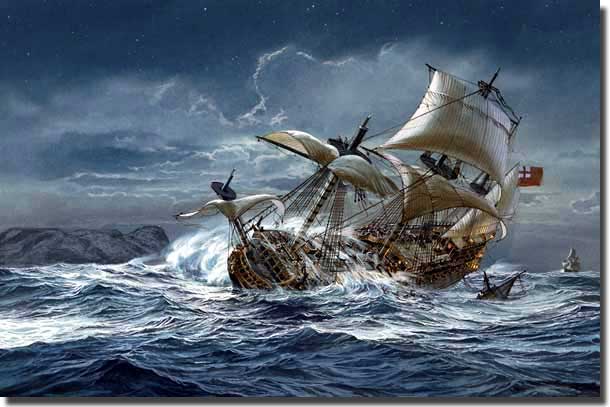|
Searching for sunken 17th. Century British warship, HMS Sussex, carrying a fortune
Odyssey Marine Exploration, the US company currently extracting gold coins fron the wreck of SS Republic off the Georgia coast is also involved with the United Kingdom on the HMS Sussex project. For the first time in history, a Government has entered into a partnership agreement with a company from the private sector for the archaeological excavation of a sovereign warship. Back in 1694, HMS Sussex, an 80 gun British warship sank in a severe storm near the Straits of Gibraltar. Research has uncovered that at this time she carried a vast sum of money, thought then to be worth a Million Pounds, it was destined to become a payment to the Duke of Savoy, then a British Ally in the war againnst France and King Louis XIV. At the time, the French were endeavouring to lure the Duke and his Army to change sides and join their banner, 6 tons of gold and 3,000,000 in money being touted as their enducement.
Illustration by Tom Freeman of HMS Sussex, foundered in 1694 close to the Straits of Gibraltar, Sussex founders. The Duke of Savoy takes up the French offer. Seeking the Sussex. Several of the sites visited turned up ancient ships, including Roman and Phoenician sites over 2,000 years old. It is amazing that such wrecks may lay undisturbed for centuries, only to have their secret resting places at last discovered by means of modern under water technology. Only one discovered site revealed the presence of warship type cannons. Very close to the position that in 1694 the Fleet Secretary had reported Sussex had sunk, warship cannons were found close to this target at 3,000 feet deep. In 2001, 10 days were spent in trying to identify this wreck, the ROV made 17 dives over a period of 75 hours, and Neil Cunningham Dobson, declared: "Study of the survey data, the historical and documentary sources, the under water investigations, the location, the size and shape of the site, and the cannon distribution and size, indicate the site is that of the Sussex." Value of the cargo. Obviously much money has already been ploughed into the Sussex Project, but the potential prize for both Odyssey and the British Government is so great that it seems to be enough to motivate them to continue to try and recover this golden hoard from the bottom of the Mediterranean. Modern technology and tenacity may yet force this glittering prize to be yielded from the ocean's grasp, and in 2003 the hunt has continued. The back cover on this book about the Sussex's secret has yet to be closed. National Geographic signs agreement. Acknowledgement. |

